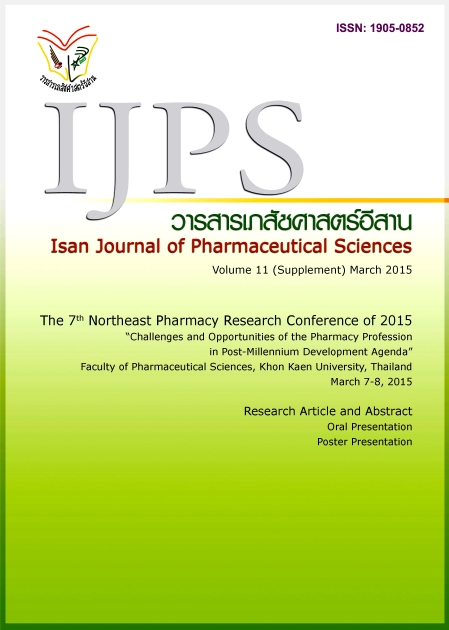Neuroprotective and Neuritogenic Activities of Melatonin and N-acetyl Substituent Derivative
Main Article Content
Abstract
Introduction: Melatonin (MLT) is the pineal hormone, which has many pharmacological activities as following antioxidant, anticancer, and immune enhancement. Due to its antioxidant ability, MLT was investigated the neuroprotective effect on neurons. However, the poor pharmacokinetic profiles such as bioavailability and rapid metabolism were its limit for pharmacological study. Therefore, the structure development is needed for improving pharmacological activity. Materials and Method: N-acetyl melatonin (AcO-MLT) was produced from the reaction of MLT and acetic anhydride by using 4,4-dimethyl aminopyridine (DMAP) as catalyst. After the reaction completed, liquid-liquid extraction and chromatographic purification were used to obtain AcO-MLT. Then, MLT and N-acetyl melatonin AcO-MLT were evaluated neuroprotective ability by serum deprivation method and neuritogenic effect in P19-derived neurons. Cell viability was measured by XTT reduction assay. Results: Both of MLT and its derivative, AcO-MLT, at 1 nM significantly protected neuron cells from toxicity of oxidative stress. From XTT reduction assay showed cell viability treated with MLT and AcO-MLT compared with oxidative stress condition group was 98.0% ± 44.3, 74.3% ± 7.4, and 15.7% ± 5.2, respectively. MLT and AcO-MLT also increased the number of neurites compared with the control (3.4 ± 1.1, 4.0 ± 1.7, and 2.0 ± 1.1, respectively). Conclusion: MLT and AcO-MLT significantly protected neuronal cell death from oxidative stress. For neuritogenic ability, MLT and AcO-MLT could promote the neurite outgrowth but could not increase the neurite length. From the result can be summarized that MLT and its N-acetylated derivative may have potential to further study and develop as a neuroprotective agent
Article Details
In the case that some parts are used by others The author must Confirm that obtaining permission to use some of the original authors. And must attach evidence That the permission has been included
References
Arendt J. Melatonin, circadian rhythms, and sleep. N Engl J Med 2000; 343(15): 1114–1116.
Beal MF. Mitochondria, free radicals, and neurodegeneration. Curr Opin Neurobiol 1996; 6(5): 661–666.
Beal MF, Lang AE, Ludolph AC. Neurodegenerative diseases: neurobiology, pathogenesis and therapeutics. Cambridge: Cambridge University Press; 2005.
Cardinali DP, Pévet P. Basic aspects of melatonin action. Sleep Med Rev 1998; 2(3): 175–190.
Checkoway H, Lundin JI, Kelada SN. Neurodegenerative diseases, IARC Sci Publ 2011; (163): 407–419.
Chung SY, Han SH. Melatonin attenuates kainic acid-induced hippocampal neurodegeneration and oxidative stress through microglial inhibition, J Pineal Res 2003; 34(2): 95-102.
Cos S, Blask DE. Effects of the pineal hormone melatonin on the anchorage-independent growth of human breast cancer cells (MCF-7) in a clonogenic culture system. Cancer Lett 199; 50(2): 115–119.
Di WL, Kadva A, Johnston A, Silman R. Variable bioavailability of oral melatonin, N Engl J Med1997; 336: 1028-1029.
Epstein FH, Brzezinski A. Melatonin in humans. N Engl J Med 1997; 336(3): 186–195.
Gallego D, Rojas M, Orozco C. Chapter 7: Free Radicals, Neuronal Death and Neuroprotection. In: Chang RCC, editor. Neurodegenerative Diseases - Processes, Prevention, Protection and Monitoring. Shanghai: InTech; 2011. 165–198.
Iacovitti L, Stull ND, Johnston K. Melatonin rescue dopamine neurons from cell death in tissue culture models of oxidative stress, Brain Research 1997; 768: 317-326
Jones-Villeneuve EM, McBurney MW, Rogers KA, Kalnins VI. Retinoic acid induces embryonal carcinoma cells to differentiate into neurons and glial cells, J Cell Biol 1982; 94(2): 253–262.
Lerner AB, Case JD, Takahashi Y, Lee TH, Mori W. Isolation of melatonin, the pineal gland factor that lightens melanocytes. J Am Chem Soc 1958; 80(10): 2587.
López-Maderuelo MD, Fernández-Renart M, Moratilla C, Renart J. Opposite effects of the Hsp90 inhibitor geldanamycin: induction of apoptosis in PC12, and differentiation in N2A cells. FEBS Letters 2001; 490: 23-27.
MacPherson PA, McBurney MW. P19 Embryonal carcinoma cells: a source of cultured neurons amenable to genetic manipulation. Methods1995; 7(3): 238–252.
Parameyong A, Charngkaew K, Govitrapong P, Chetsawang B. Melatonin attenuates methamphetamine-induced disturbances in mitochondrial dynamics and degeneration in neuroblastoma SH-SY5Y cells. J Pineal Res 2013; 55(3): 313-323.
Reiter RJ. Functional pleiotropy of the neurohormone melatonin: antioxidant protection and neuroendocrine regulation. Front Neuroendocrinol1995; 16(4): 383–415.
Srinivasan V, Maestroni GJM, Cardinali DP, Esquifino AI, Perumal SP, Miller SC. Melatonin, immune function and aging. Immun Ageing 2005; 2(1): 17.
Stull ND, Polan DP, Iacovitti L. Antioxidant compounds protect dopamine neurons from death due to oxidative stress in vitro, Brain Research 2002; 931(2): 181-185.
Tadtong S, Kanlayavattanakul M, Lourith N. Neuritogenic and neuroprotective activities of fruit residues. Nat Prod Commun 2013; 8(11): 1583-1586.

